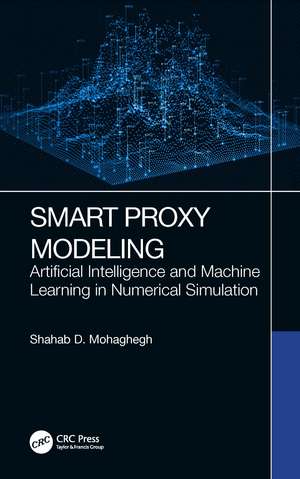Smart Proxy Modeling: Artificial Intelligence and Machine Learning in Numerical Simulation
Autor Shahab D. Mohagheghen Limba Engleză Paperback – 4 oct 2024
- Covers replication of highly accurate numerical simulations using Artificial Intelligence and Machine Learning
- Details application in reservoir simulation and modeling and computational fluid dynamics
- Includes real case studies based on commercially available simulators
| Toate formatele și edițiile | Preț | Express |
|---|---|---|
| Paperback (1) | 379.22 lei 6-8 săpt. | |
| CRC Press – 4 oct 2024 | 379.22 lei 6-8 săpt. | |
| Hardback (1) | 608.51 lei 3-5 săpt. | +17.37 lei 6-12 zile |
| CRC Press – 27 oct 2022 | 608.51 lei 3-5 săpt. | +17.37 lei 6-12 zile |
Preț: 379.22 lei
Preț vechi: 474.02 lei
-20% Nou
Puncte Express: 569
Preț estimativ în valută:
72.56€ • 75.58$ • 60.49£
72.56€ • 75.58$ • 60.49£
Carte tipărită la comandă
Livrare economică 28 martie-11 aprilie
Preluare comenzi: 021 569.72.76
Specificații
ISBN-13: 9781032151151
ISBN-10: 1032151153
Pagini: 204
Ilustrații: 418
Dimensiuni: 156 x 234 mm
Greutate: 0.45 kg
Ediția:1
Editura: CRC Press
Colecția CRC Press
Locul publicării:Boca Raton, United States
ISBN-10: 1032151153
Pagini: 204
Ilustrații: 418
Dimensiuni: 156 x 234 mm
Greutate: 0.45 kg
Ediția:1
Editura: CRC Press
Colecția CRC Press
Locul publicării:Boca Raton, United States
Notă biografică
Shahab D. Mohaghegh, a pioneer in the application of Artificial Intelligence and Machine Learning in the Exploration and Production industry, is Professor of Petroleum and Natural Gas Engineering at West Virginia University (WVU) and the president and CEO of Intelligent Solutions, Inc. (ISI). He is the director of WVU-LEADS (Laboratory for Engineering Application of Data Science).
Including more than 30 years of research and development in the petroleum engineering application of Artificial Intelligence and Machine Learning, he has authored three books (Shale Analytics – Data Driven Reservoir Modeling – Application of Data-Driven Analytics for the Geological Storage of CO2), more than 230 technical papers and carried out more than 60 projects for independents, NOCs and IOCs. He is a SPE Distinguished Lecturer (2007 and 2020) and has been featured four times as the Distinguished Author in SPE’s Journal of Petroleum Technology (JPT 2000 and 2005). He is the founder of SPE’s Technical Section dedicated to AI and machine learning (Petroleum Data-Driven Analytics, 2011). He has been honored by the U.S. Secretary of Energy for his AI-based technical contribution in the aftermath of the Deepwater Horizon (Macondo) incident in the Gulf of Mexico (2011) and was a member of U.S. Secretary of Energy’s Technical Advisory Committee on Unconventional Resources in two administrations (2008-2014). He represented the United States in the International Standard Organization (ISO) on Carbon Capture and Storage technical committee (2014-2016).
Including more than 30 years of research and development in the petroleum engineering application of Artificial Intelligence and Machine Learning, he has authored three books (Shale Analytics – Data Driven Reservoir Modeling – Application of Data-Driven Analytics for the Geological Storage of CO2), more than 230 technical papers and carried out more than 60 projects for independents, NOCs and IOCs. He is a SPE Distinguished Lecturer (2007 and 2020) and has been featured four times as the Distinguished Author in SPE’s Journal of Petroleum Technology (JPT 2000 and 2005). He is the founder of SPE’s Technical Section dedicated to AI and machine learning (Petroleum Data-Driven Analytics, 2011). He has been honored by the U.S. Secretary of Energy for his AI-based technical contribution in the aftermath of the Deepwater Horizon (Macondo) incident in the Gulf of Mexico (2011) and was a member of U.S. Secretary of Energy’s Technical Advisory Committee on Unconventional Resources in two administrations (2008-2014). He represented the United States in the International Standard Organization (ISO) on Carbon Capture and Storage technical committee (2014-2016).
Cuprins
1. Artificial Intelligence and Machine Learning. 2. Numerical simulation and modeling. 3. Proxy modeling. 4. Smart Proxy Modeling for numerical reservoir simulation. 5. Smart Proxy Modeling for computational fluid dynamics (CFD).
Descriere
Smart proxy models provide an opportunity to replicate numerical simulations with very high accuracy and can be run on a laptop within a few minutes. This book focuses on smart proxy modeling and teaches readers to develop smart proxy models using artificial intelligence and machine learning.
